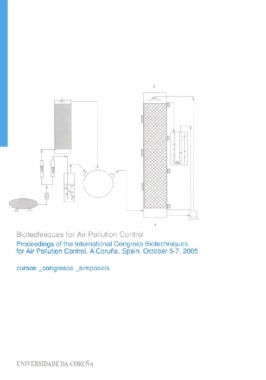La energía y las materias primas para la industria química muestran una demanda creciente. Con las limitaciones relacionadas con la disponibilidad y el uso del petróleo, la industria de la energía y el producto químico están sujetos a cambios considerables. La necesidad de utilizar materias primas más baratas y ampliamente disponibles, y el desarrollo de procesos químicos sostenibles y respetuosos con el medio ambiente está creciendo rápidamente bajo la presión económica y pública.
El tratamiento de residuos de gas se ha ido integrado en el diseño del proceso. Cada vez más las industrias intentan alcanzar la autosuficiencia y la recuperación de los compuestos de sus propias corrientes de residuos.
- Contents
- General aspects
- Biotechniques for air pollution control: past, present and future trends
- Fe(II)EDTA[sup(2-)] regeneration, biomass growth and EDTA degradation in continuous BioDeNOx reactors
- Microbiological aspects
- Stable isotope probing as an effective tool for direct identification of active microorganisms in biofilters
- Biological treatment of VOCs: Impact of the volumetric load on the selection of efficient microbial communities
- Upgraded conventional cultivation techniques for the mass production of bacterial communities adapted to the degradation of volatile organic compounds (TEX)
- Sludge acclimation and preliminary tests prior to support material inoculation in a biofilter
- Bacterial Consortia utilizing volatile organic compounds: mapping genomic determinants of essential biodegradation pathways
- Application of Real-Time PCR to monitor inoculum survival during the removal of dimethyl sulfide in biofilters and biotrickling filters
- Biodegradation of linear C5-C7 alkanes by microbial communities: kinetics and microbiological aspects
- Biodegradation of ethyl acetate and toluene mixtures by a peat biofilter: respirometry monitoring and dynamics of living and dead bacterial cells
- Removal of volatile sulphur compounds
- Effects of CO[sub(2)] and methanol on the autotrophic degradation of hydrogen sulfide in a biotrickling filter
- The elimination of odours resulting from a process of treatment of sewage sludge by biofiltration
- Comparison of two-stage and single-stage biofiltration for H[sub(2)]S and toluene co-treatment
- Deodorization of pig manure by organic bed biofiltration
- Microbiological and biochemical effects of activated sludge diffusion for sulphide biooxidation in wastewater treatment plants
- Performance evaluation of biofiltration in the removal of hydrogen sulfide from gas flue
- Biological process for H[sub(2)]S removal: acidophilic or alkalophilic
- Removal of hydrogen sulphide by immobilized Thiobacillus thioparus in a biofilter packed with polyurethane foam
- Development of a biotrickling filter for the removal of H[sub(2)]S from biogas
- H[sub(2)]S removal from wastewater treatment plants off-gases using activated sludge process
- Kinetics, mass transfer, and modelling
- Kinetic behaviors between acetone and composite bead in biofilter
- Enhancement of oxygen transfer in bioprocesses by the use of an organic phase: effect of silicone oil on volumetric mass transfer coefficient of oxygen (k[sub(L)]a)
- Biofilm growth in porous media: derivation of a macroscopic model from the physics at the pore scale via homogenization
- Henry's law constants of volatile organic compounds in activated sludge and wastewater at 298 K
- Comparison of MEK utilization and growth kinetics between batch and fixed-film processes
- Novel reactors and operating strategies
- Latest developments in high efficiency biofiltration
- Continuous bioremediation of phenol polluted air in an external loop airlift bioreactor with packed bed
- Intelligent biofilters: new control and monitoring techniques to optimise the efficiency of biological systems
- Degradation of methanethiol in an UASB reactor: reactor performance and salt tolerance
- Performance of a hollow fiber membrane bioreactor for the treatment of gaseous toluene
- Novel waste-gas treatment process: able to cope with fluctuating loads, poorly water soluble VOC and biomass accumulation
- Desulfotomaculum carboxydivorans as biocatalyst for synthesis gas purification
- Design, construction and long-term performance of novel type of industrial biotrickling filters for VOC and odour control
- Odorous emission biofiltration with new synthetic packing materials: essential nutriment release
- The removal of methyl ethyl ketone in an essentially gaseous-phase biofilm bioreactor: aspects of dynamic behavior and the influence of operating characteristics
- Comparison of organic packing materials for toluene biofiltration
- Polymer biomass carrier modificationin electric and magnetic fields
- Design and development of horizontal airflow biofilters for controlling odour from livestock facilities
- An innovating process for pollutants concentration in gaseous effluents: application to high gas flow rates with low VOC concentrations
- Air pollution control, carbon emission futures trading and constructed mangrove sinks for carbon dioxide fixation
- Novel biofiltre for the treatment of volatile organic compounds (VOCs) emitted by the wood panel industry
- Steady state and dynamic performance of a two-phase partitioning bioscrubber for the treatment of benzene gas
- The use of solid polymer beads for the capture and biodegradation of toluene in two-phase partitioning bioreactors
- Fungal reactors
- Fungal biodegradation of a-pinene in gas-phase biofilter
- Biosystematics and ecology of hydrocarbon-degrading fungi from air biofilters
- Treatment of n-hexane in fungal packed bed and stirred tank bioreactors containing two phases
- Removal of chlorinated pollutants
- Biofiltration of dichloromethane vapours: isolation of microorganisms
- Biological waste gas purification of industrial methyl chloride emissions to protect the stratospheric ozone layer
- Influence of nematodes grazing bacteria on biomass growth in a biotrickling filter treating chlorobenzenes
- Mixed VOCs and industrial applications
- Paint solvent components degradation from their mixture along the biotrickling bed height
- Evaluation of biofilter performance in the co- treatment of styrene and acrylonitrile vapors mixture
- Methanol and ethanol treatment by biotrickling filtration: an experimental study
- Biological treatment of mixtures of toxic compounds emitted from formaldehyde resin-producing industries
- Kinetics of gasoline vapor removal in a poraver filled biofilter
- Phytoremediation
- The influence of plant density on the removal efficiency of volatile organic compounds in indoor air using a biological filter
- Addendum (Microbiological aspects)
- Biodegradation of ethyl acetate and toluene mixtures by a peat biofilter: respirometry monitoring and dynamics of living and dead bacterial cells
- Real-time PCR analysis of tailored and non-specific inocula for the removal of dimethyl sulphide in a biotrickling filter

